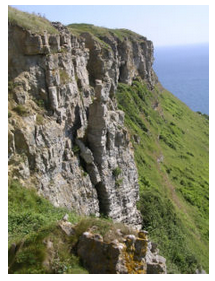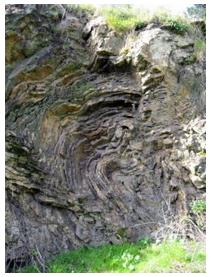7.5.2: Chemical Sedimentary Rocks
- Page ID
- 18713
\( \newcommand{\vecs}[1]{\overset { \scriptstyle \rightharpoonup} {\mathbf{#1}} } \)
\( \newcommand{\vecd}[1]{\overset{-\!-\!\rightharpoonup}{\vphantom{a}\smash {#1}}} \)
\( \newcommand{\id}{\mathrm{id}}\) \( \newcommand{\Span}{\mathrm{span}}\)
( \newcommand{\kernel}{\mathrm{null}\,}\) \( \newcommand{\range}{\mathrm{range}\,}\)
\( \newcommand{\RealPart}{\mathrm{Re}}\) \( \newcommand{\ImaginaryPart}{\mathrm{Im}}\)
\( \newcommand{\Argument}{\mathrm{Arg}}\) \( \newcommand{\norm}[1]{\| #1 \|}\)
\( \newcommand{\inner}[2]{\langle #1, #2 \rangle}\)
\( \newcommand{\Span}{\mathrm{span}}\)
\( \newcommand{\id}{\mathrm{id}}\)
\( \newcommand{\Span}{\mathrm{span}}\)
\( \newcommand{\kernel}{\mathrm{null}\,}\)
\( \newcommand{\range}{\mathrm{range}\,}\)
\( \newcommand{\RealPart}{\mathrm{Re}}\)
\( \newcommand{\ImaginaryPart}{\mathrm{Im}}\)
\( \newcommand{\Argument}{\mathrm{Arg}}\)
\( \newcommand{\norm}[1]{\| #1 \|}\)
\( \newcommand{\inner}[2]{\langle #1, #2 \rangle}\)
\( \newcommand{\Span}{\mathrm{span}}\) \( \newcommand{\AA}{\unicode[.8,0]{x212B}}\)
\( \newcommand{\vectorA}[1]{\vec{#1}} % arrow\)
\( \newcommand{\vectorAt}[1]{\vec{\text{#1}}} % arrow\)
\( \newcommand{\vectorB}[1]{\overset { \scriptstyle \rightharpoonup} {\mathbf{#1}} } \)
\( \newcommand{\vectorC}[1]{\textbf{#1}} \)
\( \newcommand{\vectorD}[1]{\overrightarrow{#1}} \)
\( \newcommand{\vectorDt}[1]{\overrightarrow{\text{#1}}} \)
\( \newcommand{\vectE}[1]{\overset{-\!-\!\rightharpoonup}{\vphantom{a}\smash{\mathbf {#1}}}} \)
\( \newcommand{\vecs}[1]{\overset { \scriptstyle \rightharpoonup} {\mathbf{#1}} } \)
\( \newcommand{\vecd}[1]{\overset{-\!-\!\rightharpoonup}{\vphantom{a}\smash {#1}}} \)
\(\newcommand{\avec}{\mathbf a}\) \(\newcommand{\bvec}{\mathbf b}\) \(\newcommand{\cvec}{\mathbf c}\) \(\newcommand{\dvec}{\mathbf d}\) \(\newcommand{\dtil}{\widetilde{\mathbf d}}\) \(\newcommand{\evec}{\mathbf e}\) \(\newcommand{\fvec}{\mathbf f}\) \(\newcommand{\nvec}{\mathbf n}\) \(\newcommand{\pvec}{\mathbf p}\) \(\newcommand{\qvec}{\mathbf q}\) \(\newcommand{\svec}{\mathbf s}\) \(\newcommand{\tvec}{\mathbf t}\) \(\newcommand{\uvec}{\mathbf u}\) \(\newcommand{\vvec}{\mathbf v}\) \(\newcommand{\wvec}{\mathbf w}\) \(\newcommand{\xvec}{\mathbf x}\) \(\newcommand{\yvec}{\mathbf y}\) \(\newcommand{\zvec}{\mathbf z}\) \(\newcommand{\rvec}{\mathbf r}\) \(\newcommand{\mvec}{\mathbf m}\) \(\newcommand{\zerovec}{\mathbf 0}\) \(\newcommand{\onevec}{\mathbf 1}\) \(\newcommand{\real}{\mathbb R}\) \(\newcommand{\twovec}[2]{\left[\begin{array}{r}#1 \\ #2 \end{array}\right]}\) \(\newcommand{\ctwovec}[2]{\left[\begin{array}{c}#1 \\ #2 \end{array}\right]}\) \(\newcommand{\threevec}[3]{\left[\begin{array}{r}#1 \\ #2 \\ #3 \end{array}\right]}\) \(\newcommand{\cthreevec}[3]{\left[\begin{array}{c}#1 \\ #2 \\ #3 \end{array}\right]}\) \(\newcommand{\fourvec}[4]{\left[\begin{array}{r}#1 \\ #2 \\ #3 \\ #4 \end{array}\right]}\) \(\newcommand{\cfourvec}[4]{\left[\begin{array}{c}#1 \\ #2 \\ #3 \\ #4 \end{array}\right]}\) \(\newcommand{\fivevec}[5]{\left[\begin{array}{r}#1 \\ #2 \\ #3 \\ #4 \\ #5 \\ \end{array}\right]}\) \(\newcommand{\cfivevec}[5]{\left[\begin{array}{c}#1 \\ #2 \\ #3 \\ #4 \\ #5 \\ \end{array}\right]}\) \(\newcommand{\mattwo}[4]{\left[\begin{array}{rr}#1 \amp #2 \\ #3 \amp #4 \\ \end{array}\right]}\) \(\newcommand{\laspan}[1]{\text{Span}\{#1\}}\) \(\newcommand{\bcal}{\cal B}\) \(\newcommand{\ccal}{\cal C}\) \(\newcommand{\scal}{\cal S}\) \(\newcommand{\wcal}{\cal W}\) \(\newcommand{\ecal}{\cal E}\) \(\newcommand{\coords}[2]{\left\{#1\right\}_{#2}}\) \(\newcommand{\gray}[1]{\color{gray}{#1}}\) \(\newcommand{\lgray}[1]{\color{lightgray}{#1}}\) \(\newcommand{\rank}{\operatorname{rank}}\) \(\newcommand{\row}{\text{Row}}\) \(\newcommand{\col}{\text{Col}}\) \(\renewcommand{\row}{\text{Row}}\) \(\newcommand{\nul}{\text{Nul}}\) \(\newcommand{\var}{\text{Var}}\) \(\newcommand{\corr}{\text{corr}}\) \(\newcommand{\len}[1]{\left|#1\right|}\) \(\newcommand{\bbar}{\overline{\bvec}}\) \(\newcommand{\bhat}{\widehat{\bvec}}\) \(\newcommand{\bperp}{\bvec^\perp}\) \(\newcommand{\xhat}{\widehat{\xvec}}\) \(\newcommand{\vhat}{\widehat{\vvec}}\) \(\newcommand{\uhat}{\widehat{\uvec}}\) \(\newcommand{\what}{\widehat{\wvec}}\) \(\newcommand{\Sighat}{\widehat{\Sigma}}\) \(\newcommand{\lt}{<}\) \(\newcommand{\gt}{>}\) \(\newcommand{\amp}{&}\) \(\definecolor{fillinmathshade}{gray}{0.9}\)Chemical sedimentary rocks are formed by precipitation of minerals from water or by alteration of already existing material in place. The most common of these rocks include evaporites, chert, and some varieties of carbonate rocks (limestones and dolostones). In contrast with clastic sedimentary rocks, petrologists name chemical sedimentary rocks based on chemical composition. This is because chemical sedimentary rocks usually include only one or a few minerals – the chemical processes that form them tend to isolate certain elements. The most common precipitated minerals consist of elements of high solubility (for example, alkalis such as sodium or potassium) or elements of great abundance (for example, silicon). Below we look at some of the different kinds of chemical sedimentary rocks in more detail.
7.5.2.1 Carbonate Rocks


While limestone is a general term given to all carbonate rocks, we use the names dolomite or dolostone for rocks in which dolomite is the dominant carbonate mineral. Limestone and dolostone account for 10% to 15% of all sedimentary rocks. They are mostly composed of calcite or dolomite, one or the other. Surprisingly, rocks with significant amounts of both calcite and dolomite are rare. Besides calcite and dolomite, carbonate rocks often contain detrital quartz or clay minerals and sometimes authigenic minerals of many kinds. Both limestones and dolostones easily weather or dissolve, producing distinctive textures such as seen in Figures 7.72 and 7.73. Commonly cracks appear enlarged, and edges are rounded.
Distinguishing limestone from dolostone, based on appearance, can be difficult or impossible in outcrop. On a fresh surface calcite and dolomite may look the same, although weathering sometimes alters dolomite to a yellow-brown color that is distinctive. Field geologists carry dilute hydrochloric acid – which reacts only with calcite or powdered dolomite – or chemical stains to help identification of carbonate minerals. Aragonite, a polymorph of calcite, exists in some very young carbonate deposits, but never in old rocks because it changes to calcite over time. In contrast, for reasons that are not completely clear, dolomite is rare in modern carbonates but is common in Paleozoic and Precambrian rocks.

When CaCO3 precipitates to form limestones, it may be as fine-grained lime muds, resulting in microcrystalline calcite, called micrite. It also precipitates as coarser sparry calcite, with crystals that may be clear and easily visible with the naked eye. However, most carbonate rocks are detrital. They form from organic debris deposited in shallow marine environments, where most biological activity occurs. These rocks often contain fossils amidst clastic grains. The fossils can be of many different sorts. The limestone in Figure 7.74 contains conspicuous ribbed brachiopods.
7.5.2.2 Evaporites
Earlier in this chapter, we discussed evaporite minerals that may accumulate in deposits that are meters or many meters thick. The most common of these deposits contain beds of halite or gypsum. Rocks composed of these two minerals are found in many places. Halite deposits may be 1,000 m thick or more, but gypsum rock deposits are generally much thinner. Both kinds of deposits form during evaporation of inland seas or other isolated waters. For example, halite and gypsum are mined in Michigan and Ontario where the minerals collected when water trapped in an inland basin, called the Michigan Basin, evaporated 360-440 million years ago. The world’s largest underground salt mine is in Goderich, Ontario, on the edge of the basin.
7.5.2.3 Chert

We talked about varieties of mineralogical chert in Section 7.4.7 above. Chert is also the name given to hard sedimentary rock composed of fine quartz crystals. The rock seen in Figure 7.75 is an example. Chert (the rock) is usually of biological origin, being the petrified remains of siliceous ooze, the biogenic sediment that covers large areas of the deep ocean floor. Chert often contains microscopic skeletal remains of diatoms, silicoflagellates, and radiolarians made of silica. Depending on its origin, chert can contain either microfossils, small macrofossils, or both. Chert (the rock) varies greatly in color (from white to black), but most often manifests as gray, brown, grayish brown and light green to rusty red (occasionally dark green too). Its color is an expression of trace elements present in the rock, and both red and green colors are most often related to small amounts of iron (in its oxidized and reduced forms respectively). Thick beds of chert, up to several hundred meters thick, underlie most of the southern plains states of the United States and parts of California. For poorly understood reasons, thick chert beds are especially common in Precambrian rocks.
7.5.2.4 Other Chemical Sedimentary Rocks
Many other types of chemical sedimentary rocks and minerals exist. They are not abundant, but they may be important as sources of ore. Collophane, a cryptocrystalline form of apatite, Ca5(PO4)3(OH,F,Cl), is found in small amounts in many kinds of sedimentary rocks. It has an organic origin, and sometimes it becomes concentrated. In rocks called phosphorites, collophane/apatite may comprise nearly the entire rock. Phosphorite mines in Wyoming and Idaho produce phosphate, an important component of fertilizers.

Iron formations, most Precambrian in age, are mined for iron in the Mesabi Range of Minnesota and elsewhere. These rocks are mostly formed from chemical sediments. Iron oxides and hydroxides, including hematite (Fe2O3), goethite (FeO(OH)) and magnetite (Fe3O4), or Fe-carbonate (siderite, FeCO3), are the most common iron minerals in iron formations. Chert is also a common component. Occasionally, iron silicates (e.g., fayalite, Fe2SiO4) or sulfide (pyrite, FeS2) may be present. The outcrop seen in Figure 7.76 is iron formation that contains layers rich in red chert alternating with layers rich in specular hematite (silver grey). Iron formations form from sediments originally deposited in shallow marine conditions. Young manganese deposits, similar to iron formations, have been dredged from ocean floors.


